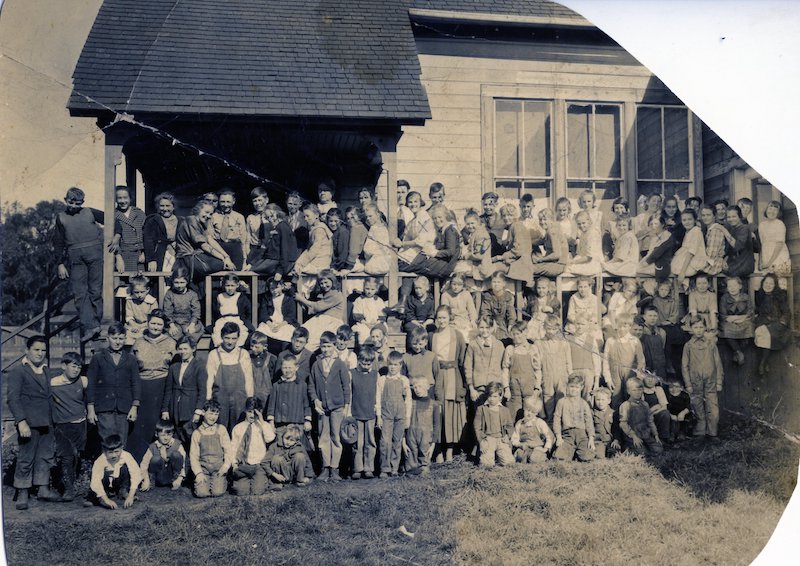Recently, the Kelley House Museum received a generous donation of teaching materials dating from between 1891 and 1906. The items had been collected from various sources and pasted into a large attendance book from 1901. Among the artifacts are notices from the Board of Education, newspaper clippings with math puzzlers, and graduation exam questions for the Grammar Schools of Mendocino County. The book belonged to Matilda “Tillie” Iversen Daniels, who was a native of Caspar and taught high school math for decades in Healdsburg. Tillie was born in 1909 to Iver Ferdinand Iversen, the superintendent at the Caspar Lumber Company for 20 years. She studied at Caspar Grammar and Fort Bragg High school before going to the College of the Pacific in Stockton for her bachelor’s and master’s degrees in the 1930s.

Caspar Grammar School in 1921. Tillie Iversen and her siblings Alice and Waldo are all present in the photograph.
A look at Tillie’s birthdate made it clear that these were not her materials; I wondered where she had gotten them and why she had preserved them. I noticed a Gualala school directory in the book listing a teacher named I. F. Iversen. This led me to examine her father’s career more closely, and I discovered that, before he served as surveyor, bookkeeper and superintendent at the lumber company, he had been a teacher. He received a teaching certificate in 1898 and worked at schools throughout Mendocino County for eight years: he taught at Wages Creek, opened a school in Gualala, and was Vice Principal at Manchester Grammar School. While teaching, he obtained a degree from San Francisco Business College and a surveyor’s license, and then he left his school days behind him. But he kept his paperwork.
A program for the 1904 Graduation Examination shows that the exam would take over a week and cover 15 subjects. In addition to basic knowledge of English, history and math, the students were expected to show mastery of “drawing and nature study,” bookkeeping and business forms, and school government (“name five duties of school trustees”). In order to graduate, students were required to score 75% overall. A student’s report card in the scrapbook shows an average score per subject of 43%. Obviously, room for improvement!
Although a majority of the materials in the scrapbook are examination questions, there were also newspaper clippings about local and state government operations, presumably for civics lessons, as well as puzzles and jokes. One of my favorites is a compilation Iverson kept of answers he had received to test questions. For example, “What are Steppe lakes?” evoked the following answer from one bright student: “A place where lakes are like steps.” “Name five differences between your school and the ‘Sleepy Hollow’ school” inspired “The Sleepy Hollow teacher had a birch switch on the wall while our teacher has a strap in his back pocket.”
I was also intrigued by a 1903 Mendocino Dispatch article titled “New Rule of the Board – High School Students May Not Drink Nor Use Tobacco,” informing educators that students who “drank alcohol, gambled, used tobacco in any form, or frequented barrooms, saloons or other questionable places” were not permitted at school. Failure to enforce the rule would lead to a teacher’s suspension. I wonder how the teachers were expected to comply. Beyond the obvious challenges of knowing when students spent time in a saloon, “other questionable places” is simultaneously too global and too unspecific to have any bearing on a teacher’s job security.
Tillie Iverson’s collection is a wonderful look into what school and education looked like over a century ago. I have particularly enjoyed learning what students were required to read and after seeing the epic poem Snow Bound: A Winter Idyl by John Greenleaf Whittier appear in nearly every examination; I am eager to add it to my own reading list.
The Kelley House Museum is open from 11:00 AM to 3:00 PM Thursday through Sunday. If you have a question for the curator, or are interested in viewing Tillie Iversen’s collection, contact her at curator@kelleyhousemuseum.org to make an appointment. Walking tours of the historic district depart from the Kelley House regularly: Tour Schedule